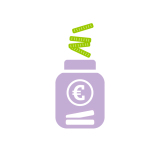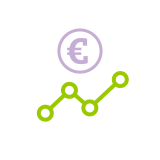Investing personal pension capital, in short:
- In the NexT Pension, you will have a personal pension capital. We invest the pension capital for you, together with the pension capital of other members. This is also the case in the current pension scheme.
- The way in which we invest your pension capital is laid down in our investment policy.
- In our investment policy, we take into account the ages of our members. This means that we are taking more risks for young people, because they still have a longer time until the start date of retirement. The closer you get to your retirement age, the less risk we take.
- You cannot make your own investment choices. But our policy does take into account the preferences of our members. To this end, we asked participants to indicate how much risk they are willing and able to take via the 'Future of Pension & Risk' survey.

Video: how does pension accrual work in the NexT Pension?
In this video, Director of Investments Anita Joosten explains what the new pension rules mean for pension accrual. She also discusses the way in which we will invest your personal pension capital. And how we take into account the age of our members.

Frequently asked questions
Questions and answers
In the solidarity based contribution plan you cannot make your own investment choices. Even though you will have your own pension capital, that capital will still be invested collectively, just as in the present set-up. In other words, the pension fund will invest the total pension capital of all its members together. You will not have the option to choose how it is invested.
The reason that you will soon not be able to make your own investment choices is the choice of the social partners for the solidarity-based contribution plan. The solidarity-based contribution plan does not allow your own investment choices. The pension assets are still invested collectively, but the return is age-dependent. If you had chosen the other variant, the flexible contribution plan, you would have been able to make your own investment choices within certain limits.
In the new solidarity-based contribution plan, the total pension assets are still collectively invested. So one investment return is achieved. However, this does not mean that all participants will also receive that return credited to their personal pension capital. According to the law, the return must be allocated to the participants on an age-related basis. The reason for this is that older participants with a shorter investment horizon invest less in commercial assets (e.g. shares) than younger participants. This means that there is actually an investment policy that is different for every age. Because we find it difficult to communicate in the form of allocation rules, we always talk about an age-related investment return that is credited to the personal pension capitals.
In the new system, the investment risk lies with the participant. This is in fact already the case in the current scheme of Philips Pensioenfonds. However, in the new system you will see the investment results more directly in your pension pot or in the amount of your benefit. Your pension will move more directly with the economy. This gives you the chance of a higher pension (if investment returns are positive), but you also run the risk of a lower pension (in the event of disappointing investment returns). Your pension will therefore become less certain. Moreover, the pension beneficiaries at Philips Pensioenfonds are protected against disappointing (investment) results by the solidarity reserve. At the time of switching to the new pension plan, that reserve will be filled using the Pension Fund’s buffer. Later, it will be topped up by withholding small amounts from the positive investment yields of the pension beneficiaries and other members aged 55 and up. The solidarity reserve will be used to top up your pension if it would otherwise need to be lowered. However, this is possible only if the solidarity reserve contains enough assets. The stability of the benefits is also increased by spreading the financial results (both positive and negative) over a number of years.
Your personal pension capital is invested collectively according to the joint investment policy, just like in the current situation. So you cannot make your own investment choices.
The basic assumption under the new pension system is that your pension capital will continue to be invested after you retire. This arrangement is called a ‘variable pension’. The portion of your pension capital that is still invested will continue to generate returns after you retire, which can be used to raise your pension.
How much pension you can draw from your pension capital after you retire will not be predetermined: it depends not only on your pension capital when you retire, but also on interest rates. Interest is a key factor in determining how much money you need in order to draw a lifelong pension. The higher the interest, the more pension your pension capital will provide, and vice versa.
If your pension capital yields more returns than the interest after you retire, it might be possible to raise your pension after you have started drawing it. The opposite is also true, however: if the returns go down, your pension could also be lowered.
Before your retirement, the investment risk will be lowered gradually, and your pension capital will be increasingly invested in safe investments such as government bonds. Those investments provide protection against fluctuating interest rates. This way, as your retirement date comes closer, you will have protection against the risks of purchasing a pension on your retirement date.
Your annual pension benefits will be updated regularly based on the market conditions at the time. Even after you start drawing your pension, interest rates will be a key factor in determining how much you can draw from your personal pension capital.
After your retirement, part of your pension capital will be invested in safe investments such as government bonds. Those investments provide protection against fluctuating interest rates.
The interest rate that will be used for purchasing a pension from your personal pension capital is, as things stand now, a yield curve prescribed by DNB. In the new law, this is referred to as the ‘projected return’: the risk-free interest rate with a margin added or deducted.
If the projected return is higher than the risk-free interest rate, your pension benefits will initially be quite high, but the risk will also be greater that the results will go down. Additionally, if the investments start yielding less, your pension benefits will need to be reduced by more.
If the projected return is lower, your initial pension benefits will also be lower, but you will be more likely to see the returns go up and your benefits increase. Additionally, if the investments start yielding less, moreover, your pension benefits will then not need to be reduced as often or by as much.
The future pension plan will be more personalised, with your own contributions and your own returns that affect your pension capital. The future interest and returns are two uncertain factors under the future pension plan. The system will make allowance for those uncertainties, for example by gradually phasing out the investment risks as your retirement date comes nearer. This offers our members protection against those risks. In addition, pension beneficiaries of Philips Pensioenfonds are protected against shortfalls in investment returns by the solidarity reserve. At the time of switching to the new pension plan, that reserve will be filled using the Pension Fund’s buffer. Later, it will be topped up by withholding small amounts from the positive investment yields of the pension beneficiaries and other members aged 55 and up. The solidarity reserve will be used to top up your pension if it would otherwise need to be lowered. However, this is possible only if the solidarity reserve contains enough assets.
Related information
The information below might also be interesting for you

Personal pension capital
In the NexT Pension, you will have a personal pension capital. This capital consists of premium from you and your employer and investment results.
Read more
Receiving a variable pension
How much pension you will receive after retirement is not fixed in advance. This depends on future investment results and the development of interest rates.
Read more